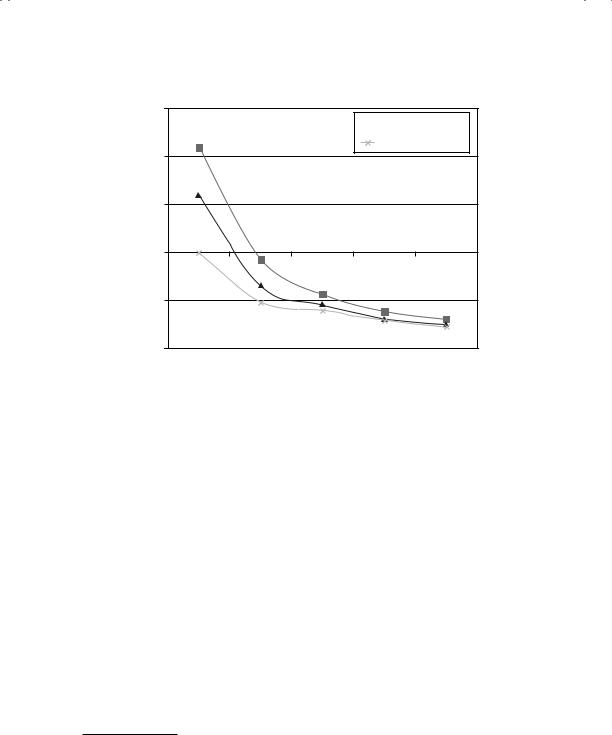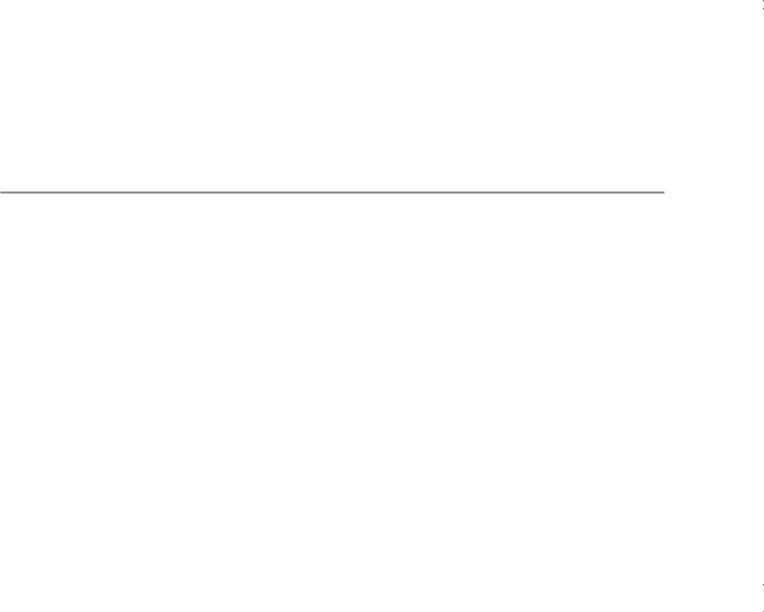
aswath_damodaran-investment_philosophies_2012
.pdf
140 |
INVESTMENT PHILOSOPHIES |
Annualized Return (net of transaction costs)
150%
100%
50%
0%
–50%
–100%
 Block Size = 100K
Block Size = 100K
 Block Size = 50K
Block Size = 50K
Block Size = 10K
0 |
1 |
5 |
10 |
15 |
Minutes after the Block Trade
F I G U R E 5 . 4 Annualized Returns from Buying after Block Trades
Source: L. Dann, D. Mayers, and R. Raab, “Trading Rules, Large Blocks and the Speed of Adjustment,” Journal of Financial Economics 4 (1977): 3–22.
These studies, however, have generally looked at heavily traded stocks at the New York Stock Exchange. On the other hand, there are others who argue that the price impact is likely to be large, especially for smaller and less liquid stocks.
Studies of the price reaction to large block trades on the floor of the exchange conclude that prices adjust within a few minutes to such trades. An early study by Dann, Mayers, and Raab examined the speed of the price reaction by looking at the returns an investor could make by buying stock right around the block trade and selling later.18 They estimated the returns after transactions as a function of how many minutes after the block trade the acquisition took place, and found that only trades made within a few minutes of the block trade had a chance of making excess returns. (See Figure 5.4.) Put another way, prices adjusted to the liquidity effects of the block trade within five minutes of the block trade, strong evidence of the capacity of markets to adjust quickly to imbalances between demand and supply.
This study suffers from a sampling bias—it looks at large block trades in large-cap, liquid stocks on the exchange floor. Studies that look at smaller,
18L. Dann, D. Mayers, and R. Raab, “Trading Rules, Large Blocks and the Speed of Adjustment,” Journal of Financial Economics 4 (1977): 3–22.

Many a Slip: Trading, Execution, and Taxes |
141 |
less liquid stocks find that the price impact tends to be larger and the adjustment back to the correct price is slower than it is for the more liquid stocks.19 There are other interesting facts about block trades that have emerged from other studies. First, while stock prices go up on block buys and go down on block sells, they are far more likely to bounce back after sell trades; when prices go up after a block buy, they are more likely to stay up.20 Another study that looks at both liquid and illiquid stocks on the NYSE also finds a tendency on the part of markets to overshoot.21 When a block buy is made, the price seems to go up too much, and it can take several days for it to revert back to a normal level for illiquid stocks.
These studies, while they establish a price impact, also suffer from another selection bias insofar as they look only at actual executions. The true cost of market impact arises from those trades that would have been done in the absence of a market impact but were not because of the perception that the impact would be large. In one of the few studies of how large this cost could be, Thomas Loeb collected bid and ask prices from specialists and market makers at a point in time for a variety of block sizes. Thus, the differences in the spreads as the block size increases can be viewed as an expected price impact from these trades. Table 5.2 summarizes his findings across stocks, classified by market capitalization.
The sectors refer to market capitalization and show the negative relationship between company size and price impact. Note, however, the effect of increasing block sizes on expected price impact within each sector; larger trades elicit much larger price impact than do smaller trades.
While the Loeb study suggests that price impact can create very large costs, studies of actual trades suggest that institutional investors have learned how to reduce, if not eliminate, these costs by modifying their trading behavior. First, large trades are increasingly done off the floor of the exchange, and there is some evidence that these off-floor trades have a smaller price impact than the trades on the floor. Second, to the extent that trades can be broken into smaller blocks and executed almost simultaneously, the price
19J. Hasbrouck, “Measuring the Information Content of Stock Trades,” Journal of Finance 66 (1991): 179–207.
20R. W. Holthausen, R. W. Leftwich, and D. Mayers, “Large-Block Transactions, the Speed of Response, and Temporary and Permanent Stock-Price Effects,” Journal of Financial Economics 26 (1990): 71–95; D. B. Keim and A. Madhavan, “Anatomy of the Trading Process: Empirical Evidence on the Behavior of Institutional Trades,”
Journal of Financial Economics 37 (1995): 371–398.
21L. Spierdijk, T. Nijman, and A. H. O. van Soest, “The Price Impact of Trades in Illiquid Stocks in Periods of High and Low Market Activity” (working paper, Tilburg University, 2002).

142
T A B L E 5 . 2 Round-Trip Transaction Costs as a Function of Market Capitalization and Block Size
|
|
|
|
Dollar Value of Block ($ thousands) |
|
|
|
||
|
|
|
|
|
|
|
|
|
|
Sector |
5 |
25 |
250 |
500 |
1,000 |
2,500 |
5,000 |
10,000 |
20,000 |
|
|
|
|
|
|
|
|
|
|
Smallest |
17.30% |
27.30% |
43.80% |
|
|
|
|
|
|
2 |
8.90% |
12.00% |
23.80% |
33.40% |
|
|
|
|
|
3 |
5.00% |
7.60% |
18.80% |
25.90% |
30.00% |
|
|
|
|
4 |
4.30% |
5.80% |
9.60% |
16.90% |
25.40% |
31.50% |
|
|
|
5 |
2.80% |
3.90% |
5.90% |
8.10% |
11.50% |
15.70% |
25.70% |
|
|
6 |
1.80% |
2.10% |
3.20% |
4.40% |
5.60% |
7.90% |
11.00% |
16.20% |
|
7 |
1.90% |
2.00% |
3.10% |
4.00% |
5.60% |
7.70% |
10.40% |
14.30% |
20.00% |
8 |
1.90% |
1.90% |
2.70% |
3.30% |
4.60% |
6.20% |
8.90% |
13.60% |
18.10% |
Largest |
1.10% |
1.20% |
1.30% |
1.71% |
2.10% |
2.80% |
4.10% |
5.90% |
8.00% |
|
|
|
|
|
|
|
|
|
|
Source: T. Loeb, “Trading Costs: The Critical Link between Investment Information and Results,” Financial Analysts Journal 39 (1983): 39–44.

Many a Slip: Trading, Execution, and Taxes |
143 |
impact costs can be reduced. Notwithstanding these developments, it still remains true that an investor desirous of either acquiring or divesting a large block of stock in a company will have to pay a price for immediacy.
D e t e r m i n a n t s o f t h e P r i c e I m p a c t a n d I m p l i c a t i o n s f o r I n v e s t m e n t S t r a t e g i e s Looking at the evidence, the variables that determine that price impact of trading seem to be the same variables that drive the bid-ask spread. That should not be surprising. The price impact and the bid-ask spread are both a function of the liquidity of the market. The inventory costs and adverse selection problems are likely to be largest for stocks where small trades can move the market significantly.
Drawing on our earlier discussion of bid-ask spreads, the price impact is likely to be greater for less liquid, smaller market capitalization companies that are closely held, for the same reasons that bid-ask spreads are high for these companies. The price impact is likely to be higher in emerging markets than in developed markets and during periods of market crisis (such as the last quarter of 2008).
Since you can reduce the price impact of trades by breaking them up into smaller trades, the price impact cost is likely to be greatest for investment strategies that require instantaneous trading. Thus, a portfolio manager who buys small, illiquid stocks because they are undervalued is likely to face a smaller price impact cost than an investor who buys the same stocks after positive earnings announcements. The former can afford to spread the trades over time whereas the latter has to trade right after the announcement.
The price impact effect also will come into play when a small portfolio manager, hitherto successful with an investment strategy, tries to scale up the strategy. There are many investment strategies that deliver high riskadjusted returns on a small scale but fail in larger portfolios because the price impact costs rise.
T h e O p p o r t u n i t y C o s t o f W a i t i n g
The final component of trading costs is the opportunity cost of waiting. An investor can reduce the bid-ask spread and price impact costs of trading by trading patiently. If, in fact, there were no cost to waiting, even a large investor could break up trades into small lots and buy or sell large quantities without affecting the price or the spread significantly. There is, however, a cost to waiting. In particular, the price of an asset that an investor wants to buy because he or she believes that it is undervalued may rise while the investor waits to trade, and this, in turn, can lead to one of two consequences. One is that the investor does eventually buy, but at a much higher price, reducing expected profits from the investment. The other is that the price

144 |
INVESTMENT PHILOSOPHIES |
rises so much that the asset is no longer undervalued and the investor does not trade at all. A similar calculus applies when an investor wants to sell an asset that he or she thinks is overvalued.
The cost of waiting will depend in great part on the probability that the investor assigns that the price will rise (or fall) while he or she waits to buy (or sell). We would argue that this probability will be a function of why the investor thinks the asset is undervalued or overvalued. In particular, the following four factors should affect this probability:
1.Is the valuation assessment based on private information or is it based on public information? Private information tends to have a short shelf life in financial markets, and the risks of sitting on private information are much greater than the risks of waiting when the valuation assessment is based on public information. Thus, the cost of waiting is much larger when the strategy is to buy on the rumors (or information) of a possible takeover than it would be in a strategy of buying low price-earnings (P/E) ratio stocks.
2.How active is the market for information? Building on the first point, the risks of waiting, when one has valuable information, are much greater in markets where there are other investors actively searching for the same information. Again, in practical terms, the costs of waiting will be greater when there are dozens of analysts following the target stock than when there are few other investors paying attention to the stock.
3.How long term or short term is the strategy? While this generalization does not always hold, short-term strategies are more likely to be affected by the cost of waiting than longer-term strategies are. Some of this can be attributed to the fact that short-term strategies are more likely to be motivated by private information, whereas long-term strategies are more likely to be motivated by views on value.
4.Is the investment strategy a contrarian or momentum strategy? In a contrarian strategy, where investors are investing against the prevailing tide (buying when others are selling or selling when others are buying), the cost of waiting is likely to be smaller precisely because of this behavior. In contrast, the cost of waiting in a momentum strategy is likely to be higher since the investor is buying when other investors are buying and selling when others are selling.
In summary, the cost of waiting is likely to be greatest for short-term investment strategies, based on private information or momentum, in markets with active information gathering. It will be less of an issue for longterm investment strategies based on public information and for contrarian strategies.

Many a Slip: Trading, Execution, and Taxes |
145 |
T A B L E 5 . 3 Total Round Trip Trading Costs and Market Capitalization, 1991 to 1993
Market |
Implicit |
Explicit |
Total Trading |
Total Trading |
Capitalization |
Cost |
Cost |
Costs (NYSE) |
Costs (NASDAQ) |
|
|
|
|
|
Smallest |
2.71% |
1.09% |
3.80% |
5.76% |
2 |
1.62% |
0.71% |
2.33% |
3.25% |
3 |
1.13% |
0.54% |
1.67% |
2.10% |
4 |
0.69% |
0.40% |
1.09% |
1.36% |
Largest |
0.28% |
0.28% |
0.31% |
0.40% |
|
|
|
|
|
Source: D. B. Keim and A. Madhavan, “The Cost of Institutional Equity Trades,”
Financial Analysts Journal 54 (1998): 50–69.
I n v e s t m e n t S t r a t e g y a n d T o t a l T r a d i n g C o s t s
The fact that assets that have high bid-ask spreads also tend to be assets where trading can have a significant price impact makes it even more critical that we examine with skepticism investment strategies that focus disproportionately in these assets. With the price impact, the effect of the size of the portfolio becomes much more important, since large portfolios beget large trading blocks, which, in turn, have the biggest price impact. Thus, a strategy of investing in low-priced stocks that are not followed by analysts may yield excess returns, even after the bid-ask spread is considered, for a portfolio of $250 million but cease to be profitable if that same portfolio becomes $5 billion.
Keim and Madhavan examine the interrelationship between total trading costs—implicit (including price impact and opportunity costs) as well as explicit (commissions and spreads)—and investment strategies.22 Not surprisingly, they find that strategies that require large block trades have much higher total trading costs than strategies with smaller trades. They also find that the total trading costs are much greater for investors who buy small market cap stocks as opposed to large market cap ones. Table 5.3 provides a summary of their estimates of total trading costs for small-cap and large-cap companies listed on the NYSE and NASDAQ from 1991 to 1993.
Note that the smallest companies have total round-trip trading costs that are significantly higher than the largest companies. They also find significant differences in costs between managers with different trading styles, with
22D. B. Keim, and A. Madhavan, “The Cost of Institutional Equity Trades,” Financial Analysts Journal 54 (1998): 50–69.

146 |
INVESTMENT PHILOSOPHIES |
technical traders having the highest costs (presumably because of their need for immediate execution) and value traders having the lowest costs.
T R A D I N G C O S T S W I T H N O N T R A D E D A S S E T S
If the cost of trading stocks can be substantial, it should be even more significant if your investment strategy requires you to hold assets that are not traded regularly, such as collectibles, real estate, or equity positions in private companies. In this section, we consider these costs.
T r a d i n g C o s t s o n R e a l A s s e t s
Real assets can range from gold to real estate to fine art, and the transaction costs associated with trading these assets can also vary substantially. The smallest transaction costs are associated with commodities—gold, silver, or diamonds—since they tend to come in standardized units. With residential real estate, the commission that you have to pay a real estate broker or salesperson can be 5 to 6 percent of the value of the asset. With commercial real estate, commissions may be a smaller percentage for larger transactions, but they will still be substantial. With fine art or collectibles, the commissions become even higher. If you sell a painting through one of the auction houses, you may have to pay 15 to 20 percent of the value of the painting as a commission.
Why are the costs so high? The first reason is that there are far fewer intermediaries in real asset businesses than there are in the stock or bond markets; this reduces competition. The second is that real estate and fine art are not standardized products. In other words, one Picasso can be very different from another, and you often need the help of experts to authenticate the painting, judge value and arrange transactions. This adds to the cost in the process.
T r a d i n g C o s t s o n P r i v a t e E q u i t y / B u s i n e s s e s
If your strategy requires you to take positions in private businesses—private equity, as it is called—you have to allow for the fact that lucrative though the returns from these investments may be, the investments are illiquid. It is common, in fact, for investors in private businesses to assess an illiquidity discount on value to reflect their expectation that the cost of liquidating their position will be high. In this section, we consider some of the factors that will determine this cost and empirical assessments of how big the cost may be.

Many a Slip: Trading, Execution, and Taxes |
147 |
D e t e r m i n a n t s o f I l l i q u i d i t y C o s t The cost of illiquidity is likely to vary across both firms and buyers, which renders rules of thumb useless. Let us consider first four of the factors that may cause the cost to vary across firms.
1.Liquidity of assets owned by the firm. The fact that a private firm is difficult to sell may be rendered moot if its assets are liquid and can be sold with no significant loss in value. A private firm with significant holdings of cash and marketable securities should have a lower illiquidity cost than one with factories or other assets for which there are relatively few buyers.
2.Financial health and cash flows of the firm. A private firm that is financially healthy should be easier to sell than one that is not healthy. In particular, a firm with strong income and positive cash flows should be subject to a smaller illiquidity cost than one with negative income and cash flows.
3.Possibility of going public in the future. The greater the likelihood that a private firm can go public in the future, the lower should be the illiquidity cost. In effect, the probability of going public is built into the valuation of the private firm.
4.Size of the firm. If we state the illiquidity cost as a percentage of the value of the firm, it should become smaller as the size of the firm increases. In other words, the illiquidity discount should be smaller as a percentage of firm value for firms like Cargill and Koch Industries, which are worth billions of dollars, than it should be for a small firm worth a few million.
The illiquidity cost is also likely to vary across potential buyers because the desire for liquidity varies among individuals. It is likely that those buyers who have deep pockets and see little or no need to cash out their equity positions will face lower illiquidity costs than buyers that have less of a safety margin and a greater need for cash.
E m p i r i c a l E v i d e n c e o n I l l i q u i d i t y C o s t How large is the cost of being illiquid? This is a very difficult question to answer because the discount attached to an asset’s value itself cannot be observed. Even if we were able to obtain the terms of all private firm transactions, note that what is reported is the price at which private firms are bought and sold. The value of these firms is not known—and the illiquidity discount is the difference between the value and the price.
In fact, much of the evidence on illiquidity discounts comes from examining restricted stock at publicly traded firms. Restricted securities are securities issued by a publicly traded company but not registered with the

148 |
INVESTMENT PHILOSOPHIES |
Securities and Exchange Commission (SEC); these securities can be sold through private placements to investors but cannot be resold in the open market for a two-year holding period, and only limited amounts can be sold after that. When this stock is issued, the issue price is set much lower than the prevailing market price, which is observable, and the difference is viewed as a discount for illiquidity. There have been several studies of restricted stock, and while they vary on the degree of the discount at which restricted stocks are placed, they all report significant discounts.23
In summary, then, there seems to be a substantial discount attached to value, at least on average, when an investment is not liquid. Much of the practice of estimating illiquidity discounts seems to build on these averages. For instance, rules of thumb often set the illiquidity discount at 20 to 30 percent of estimated value, and there seems to be little or no variation in this discount across firms.
M A N A G E M E N T O F T R A D I N G C O S T S
The preceding discussion makes clear out not only how large the trading cost problem is for active money managers, but also how difficult it is to develop a strategy to minimize the collective cost. Actions taken to reduce one type of trading cost (say, the brokerage commission or bid-ask spread) may increase another (for instance, the price impact). Strategies designed to minimize the collective impact of the bid-ask spread and the price impact (such as breaking up trades and using alternative trading routes) may increase the opportunity cost of waiting. In this section, we examine ways in which trading costs can be managed within the broader construct of maximizing portfolio returns, given an investment philosophy.
Step 1: Develop a coherent investment philosophy and a consistent investment strategy.
The first step in managing trading costs is developing and staying with a coherent investment philosophy and strategy. The portfolio managers who pride themselves on style switching and moving from one investment philosophy to another are the ones who bear the biggest burden in terms of transaction costs, partly because style switching increases turnover and partly
23W. L. Silber, “Discounts on Restricted Stock: The Impact of Illiquidity on Stock Prices,” Financial Analysts Journal 47 (1991): 60–64. The median discount on restricted stock in most of the studies that look at them is between 30 percent and 40 percent.

Many a Slip: Trading, Execution, and Taxes |
149 |
because it is difficult to develop a trading strategy without a consistent investment philosophy.
Step 2: Estimate the cost of waiting, given the investment strategy.
The second step in the process is determining the cost of waiting for the investment strategy that is being followed. As noted in the previous section, the cost of waiting is likely to be small for long-term, contrarian strategies and greater for short-term, information-based, and momentum strategies. If the cost of waiting is very high, then the objective has to be minimize this cost, which essentially translates into trading as quickly as one can, even if the other costs of trading increase as a consequence.
Step 3: Look at the alternatives available to minimize transaction costs, given the cost of waiting.
Once the cost of waiting has been identified, the investor can consider the third step, which is to minimize the effect of the bid-ask spread and the price impact on portfolio returns. While we have talked about trading primarily in terms of trading on the floor of the exchange, there are a number of options that an investor can use to reduce the trading costs. Rose and Cushing make some of the following suggestions to reduce trading costs on a portfolio for an institutional investor:24
Take advantage of the alternatives to trading on the floor of the exchange. Among these alternatives are using the upstairs block market (where large buyers and sellers trade with each other), the dealer market (where trades are made with a dealer), and crossing networks (where trades are executed over a network). The trade-off is straightforward— the approaches that yield the most liquidity (the exchange floor and the dealer market) are also the ones that have the highest trading costs.
Trade portfolios rather than individual stocks when multiple orders have to be placed. Portfolio trades generally result in lower trading costs and allow for better risk management and hedging capabilities.
Use technology to reduce the paperwork associated with trading and to keep track of trades that have already been made. By allowing traders to have information on whether their trades have been executed, and on trades that have already been made, technology can help control costs.
24J. D. Rose and D. C. Cushing, “Making the Best Use of Trading Alternatives,” in Execution Techniques, True Trading Costs and the Microstructure of Markets
(AIMR, 1996).
